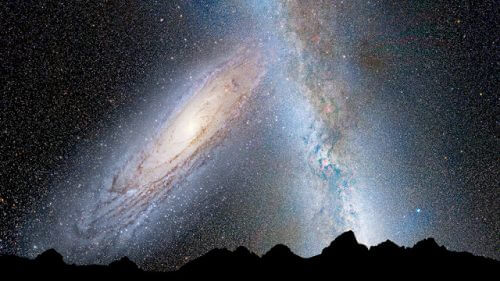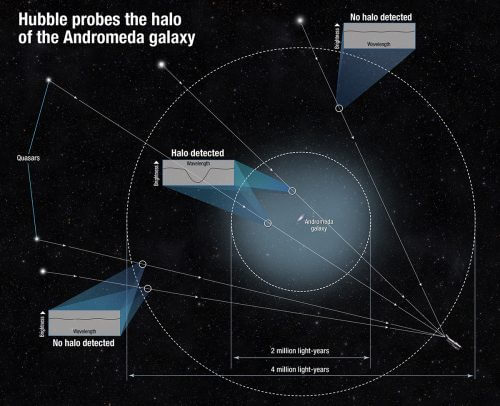The Milky Way Galaxy and Andromeda are not supposed to collide for the next 4 billion years. But in view of the recent discovery of a massive and huge halo of hot gas adjacent to Andromeda - it is very possible that the two galaxies are already touching each other

The Milky Way Galaxy and Andromeda are not supposed to collide for the next 4 billion years. But in view of the recent discovery of a massive and huge halo of hot gas adjacent to Andromeda - it is very possible that the two galaxies are already touching each other.
The Andromeda Galaxy, also known as M31, is 2.5 million light-years away from the Milky Way, and is considered our near twin. The two galaxies are the largest in a group of 54 galaxies, called the "Local Group". Andromeda, whose number of stars is twice that of the Milky Way - almost a trillion (10 to the 18th power) stars - shines with high brightness, and in a very dark sky you can simply see it with the eye without any auxiliary equipment - a pale object that is about 6 times the diameter of a full moon.
Using the Hubble Space Telescope, astrophysicist Nicholas Lehner and his colleagues from the University of Notre Dame in Indiana identified an enormous halo of hot, ionized gas around Andromeda, which was about 2 million light years across. The huge halo of gas surrounding Andromeda has been noticed before, but now it turns out that it is about 6 times larger and 1,000 times more massive than previously measured.

If the discovered halo extends at least a million light-years in our direction, the two galaxies are actually much closer to touching than previously thought.
Lehner defines halos as "gaseous atmospheres of galaxies". Despite its enormous size, Andromeda's aura is dark, almost invisible. To notice it and study it, astronomers used quasars, which are distant objects that reside within the centers of active galaxies and emit enormous amounts of energy. For example, the brightest quasar in the Virgo cluster, 3C273, is easily discernible with just a 6-inch telescope. It is now fairly widely agreed that the center of the quasar is a supermassive black hole.
The bright, pinpoint nature of quasars makes them perfect aids in astronomical measurements. When the light from the quasar reaches the direction of the Hubble, the gas in the halo absorbs some of it and the quasar will appear slightly darker in a very small range of wavelengths. Measuring this ambiguity in brightness allows researchers to determine how much gas originating from the Andromeda halo is between us and that quasar.
Astronomers have studied halos around 44 other galaxies, but the halo around Andromeda is the most massive found. Due to its proximity to the Earth and the large space it occupies in the sky, it was possible to use many quasars - 18 quasars - to clearly outline its full extent. The other haloes examined were from very distant galaxies, and only a single quasar or single data point was accessible to determine the size and structure of each halo.
For the purpose of their research, the scientists used Hubble's unique ability to absorb ultraviolet light from quasars. Ultraviolet light is difficult to see in ground-based telescopes, as it is absorbed by the Earth's atmosphere. The researchers looked at 5 years of observations stored in the Hubble data archive to conduct the study.
The mass of the measured halo is about half the mass of the stars in the Andromeda galaxy itself, in the form of diffuse hot gas. From simulations made it seems that it was formed at the same time that Andromeda was formed. Although the halo is mainly composed of ionized hydrogen - actually exposed protons and electrons - it is nevertheless incredibly rich in heavier elements, perhaps those that came from supernovae. Aggressively exploding supernovae within the visible galaxy may have blown elements such as iron, silicon, oxygen and other similar elements far into the halo and into space.
Previous studies have shown that during Andromeda's lifetime, nearly half of all the heavy elements that accumulated in its stars were ejected far outside the galaxy's stellar disk, which is 200,000 light-years across.
What does this mean for our galaxy? Since we live inside the Milky Way, scientists cannot determine if such a massive halo also surrounds us - a classic case of "you can't see the forest for the trees". But if the Milky Way has a similarly massive halo, it is possible that the halos of the two galaxies are already touching and merging quietly, long before the two massive galaxies themselves collide and merge to form a giant elliptical galaxy in about 4 billion years.
The report on the mourning website
The article in The Astrophysical Journal
More of the topic in Hayadan:

5 תגובות
The universe is indeed expanding but the "speed" at which the universe is expanding depends on the distance between the two points you are looking at:
Each point moves away from another point according to Hubble's constant, which is between 60-70 km per 3.16 light-years (farsec), therefore expansion at certain distances will be "offset" with the pull of gravity, as between the Milky Way and Andromeda.
Isn't the universe expanding?
Well, we'll live and see... 🙂
Ahh
Ok, so that's why the rate of expansion of the galaxy seems faster to us. And there is a new galaxy the Milky Way + Andromeda. A hybrid giant.